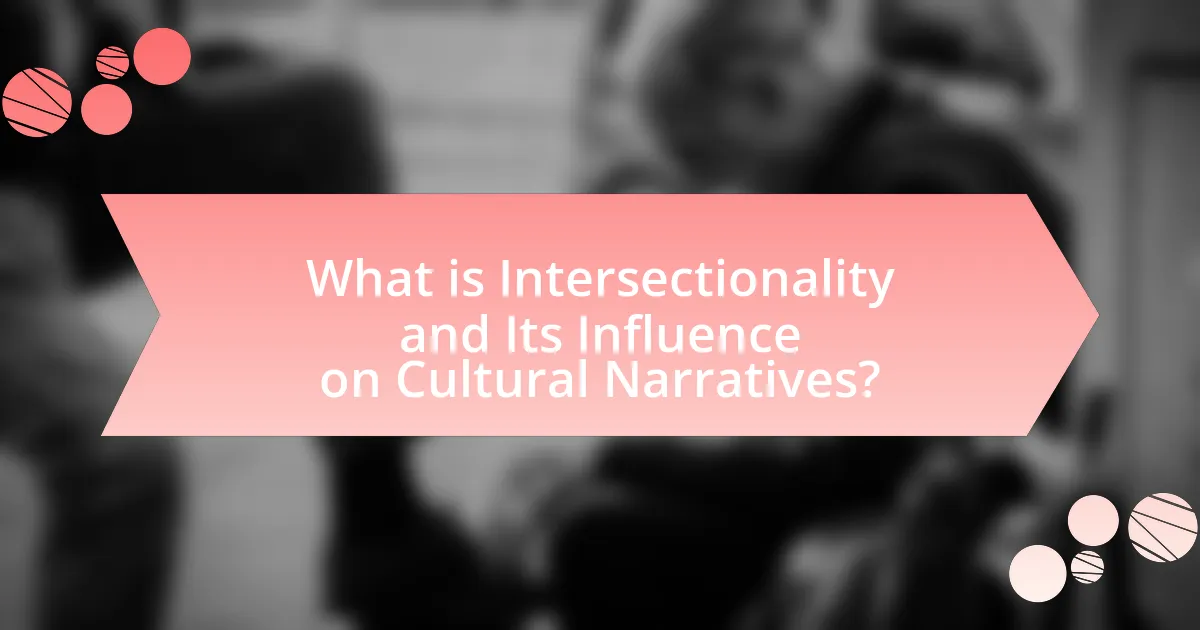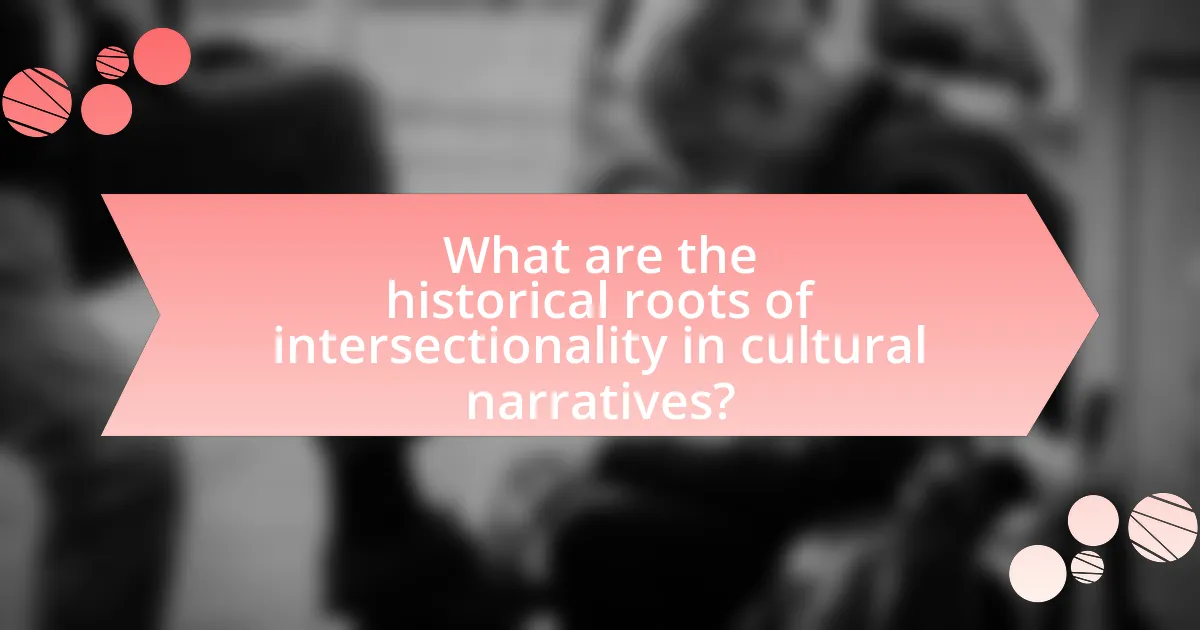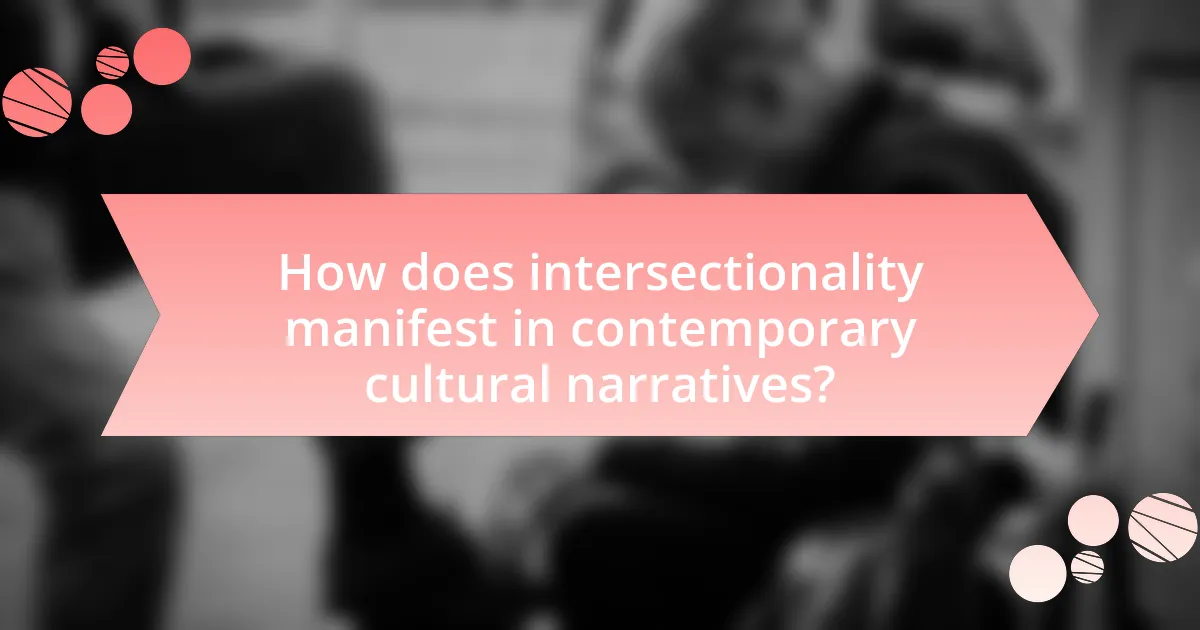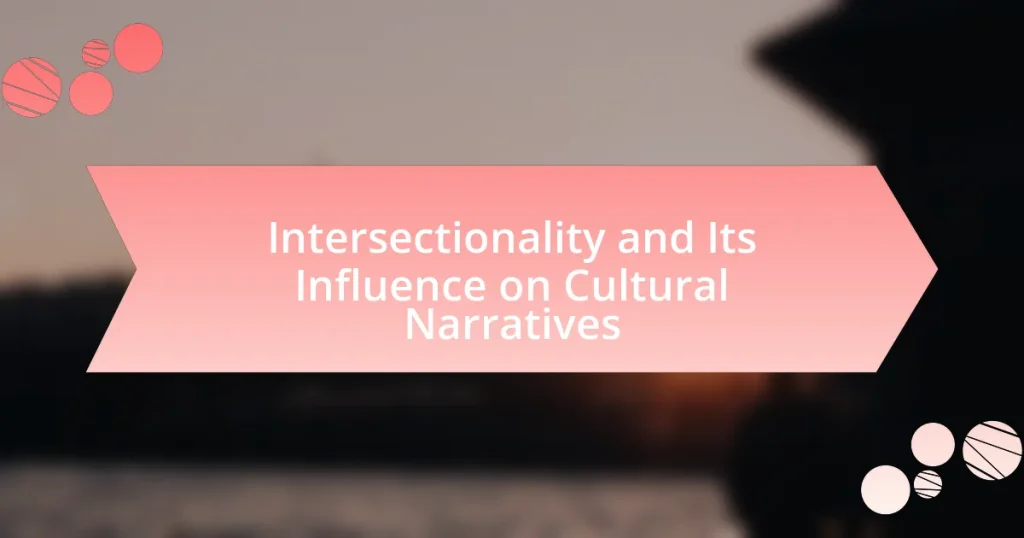Intersectionality is a framework that analyzes how various social identities, including race, gender, sexuality, and class, intersect to create distinct experiences of discrimination and privilege. This article explores the influence of intersectionality on cultural narratives, emphasizing its role in shaping inclusive storytelling that reflects the complexities of individual experiences. Key components of intersectionality, its historical roots, and its impact on representation and social justice movements are discussed, alongside examples from literature and media. The article highlights the importance of understanding intersectionality for fostering empathy and promoting diverse perspectives in cultural contexts.

What is Intersectionality and Its Influence on Cultural Narratives?
Intersectionality is a framework that examines how various social identities, such as race, gender, sexuality, and class, intersect to create unique modes of discrimination and privilege. This concept influences cultural narratives by highlighting the complexity of individual experiences and challenging monolithic representations in media and literature. For instance, Kimberlé Crenshaw, who coined the term, emphasizes that understanding these intersections is crucial for addressing systemic inequalities, as seen in movements like Black Lives Matter, which advocate for the rights of marginalized groups by acknowledging their diverse identities. This nuanced perspective reshapes cultural narratives, allowing for more inclusive storytelling that reflects the realities of individuals facing multiple forms of oppression.
How does intersectionality shape cultural narratives?
Intersectionality shapes cultural narratives by highlighting the interconnected nature of social identities and their collective impact on individual experiences. This framework reveals how overlapping identities—such as race, gender, sexuality, and class—interact to create unique perspectives and challenges, thereby influencing the way stories are told and understood in society. For instance, the representation of Black women in media often reflects both racial and gender biases, which can lead to narratives that either marginalize or empower these identities. Research by Kimberlé Crenshaw, who coined the term “intersectionality,” emphasizes that understanding these intersections is crucial for addressing systemic inequalities and fostering more inclusive cultural narratives.
What are the key components of intersectionality?
The key components of intersectionality include social categories such as race, gender, class, sexuality, ability, and age, which interact to create overlapping systems of discrimination or disadvantage. Intersectionality emphasizes that individuals experience multiple, interconnected identities that shape their social experiences and access to resources. For instance, a Black woman may face both racial and gender discrimination, which cannot be understood separately. This framework was developed by Kimberlé Crenshaw in the late 1980s, highlighting the need to consider how various forms of inequality intersect rather than viewing them in isolation.
How do different identities intersect to influence narratives?
Different identities intersect to influence narratives by shaping individual perspectives and experiences, which in turn affect how stories are told and understood. For instance, the intersection of race, gender, and socioeconomic status can lead to unique storytelling that highlights specific challenges and triumphs faced by marginalized groups. Research by Kimberlé Crenshaw emphasizes that understanding these intersections is crucial for recognizing the complexities of social issues, as narratives often reflect the lived realities of individuals at these crossroads. This intersectional approach reveals how dominant narratives can marginalize certain voices while elevating others, ultimately influencing societal perceptions and cultural discourse.
Why is understanding intersectionality important in cultural contexts?
Understanding intersectionality is crucial in cultural contexts because it reveals how overlapping social identities, such as race, gender, and class, shape individual experiences and societal dynamics. This framework allows for a more nuanced analysis of power structures and inequalities, highlighting that people’s experiences cannot be understood through a single lens. For instance, a study by Crenshaw (1989) introduced the concept of intersectionality, demonstrating that Black women face unique challenges that are not fully addressed by examining race or gender in isolation. This understanding fosters inclusivity and informs cultural narratives, ensuring diverse perspectives are represented and acknowledged.
What role does intersectionality play in representation?
Intersectionality plays a crucial role in representation by highlighting how various social identities, such as race, gender, sexuality, and class, intersect to shape individual experiences and perspectives. This framework allows for a more nuanced understanding of representation, as it reveals that individuals are not defined by a single identity but by multiple, overlapping identities that influence their social standing and visibility. For instance, studies have shown that media representation often fails to capture the complexities of marginalized groups, leading to stereotypes that do not reflect the realities of those who belong to multiple marginalized identities. By employing an intersectional lens, creators and scholars can advocate for more inclusive narratives that accurately represent the diverse experiences of individuals, thereby fostering greater empathy and understanding within cultural narratives.
How does intersectionality affect the interpretation of cultural texts?
Intersectionality affects the interpretation of cultural texts by highlighting how overlapping social identities, such as race, gender, class, and sexuality, shape individual experiences and perspectives. This framework allows readers and critics to analyze cultural texts through multiple lenses, revealing the complexities of power dynamics and social inequalities embedded within them. For instance, Kimberlé Crenshaw, who coined the term “intersectionality,” emphasizes that traditional analyses often overlook the unique experiences of individuals at the intersections of various identities, leading to a more nuanced understanding of cultural narratives. By applying intersectionality, interpreters can uncover marginalized voices and challenge dominant narratives, thus enriching the discourse surrounding cultural texts.

What are the historical roots of intersectionality in cultural narratives?
The historical roots of intersectionality in cultural narratives can be traced back to the work of legal scholar Kimberlé Crenshaw in the late 1980s, who introduced the term to highlight how various forms of social stratification, such as race, gender, and class, intersect to create unique experiences of oppression. Crenshaw’s analysis was grounded in the experiences of Black women, illustrating how traditional feminist and anti-racist discourses often failed to address the complexities of their realities. This foundational work has influenced cultural narratives by emphasizing the importance of considering multiple identities and systemic inequalities, leading to a broader understanding of social justice that incorporates diverse perspectives and experiences.
How did intersectionality emerge as a concept?
Intersectionality emerged as a concept in the late 1980s, primarily through the work of legal scholar Kimberlé Crenshaw. Crenshaw introduced the term to describe how various forms of social stratification, such as race, gender, and class, intersect and create unique experiences of discrimination and privilege. Her seminal paper, “Mapping the Margins: Intersectionality, Identity Politics, and Violence against Women of Color,” published in 1991, provided a framework for understanding how overlapping identities affect individuals’ social experiences and access to resources. This foundational work highlighted the inadequacies of single-axis frameworks in addressing the complexities of social inequality, thus establishing intersectionality as a critical lens in feminist theory and social justice movements.
Who were the key figures in the development of intersectionality?
The key figures in the development of intersectionality include Kimberlé Crenshaw, Patricia Hill Collins, and Angela Davis. Kimberlé Crenshaw introduced the term “intersectionality” in her 1989 paper, highlighting how overlapping social identities, particularly race and gender, create unique experiences of discrimination. Patricia Hill Collins expanded on these ideas in her work on Black feminist thought, emphasizing the interconnectedness of race, class, and gender. Angela Davis contributed to the discourse by linking intersectionality to broader social justice movements, advocating for the recognition of multiple identities in the fight against oppression. These scholars collectively shaped the framework of intersectionality, influencing cultural narratives and social justice activism.
What historical events contributed to the rise of intersectionality?
The rise of intersectionality was significantly influenced by the civil rights movement of the 1960s, which highlighted the interconnectedness of race, gender, and class in the struggle for equality. This movement laid the groundwork for understanding how various social identities intersect to create unique experiences of oppression. Additionally, the feminist movements of the 1970s and 1980s, particularly the work of scholars like Kimberlé Crenshaw, further developed the concept by emphasizing that traditional feminist discourse often overlooked the experiences of women of color. These historical events collectively contributed to the emergence of intersectionality as a critical framework for analyzing social inequalities.
What impact has intersectionality had on cultural movements?
Intersectionality has significantly shaped cultural movements by highlighting the interconnectedness of various social identities and their collective impact on experiences of oppression and privilege. This framework has enabled activists and scholars to address the complexities of social justice issues, leading to more inclusive and representative cultural narratives. For instance, the feminist movement has evolved to incorporate the voices of women of color, individuals, and those from different socioeconomic backgrounds, thereby broadening its scope and effectiveness. Research by Kimberlé Crenshaw, who coined the term “intersectionality,” illustrates how overlapping identities can lead to unique forms of discrimination, which has influenced cultural movements to adopt a more nuanced approach in advocating for equity and representation.
How has intersectionality influenced feminist movements?
Intersectionality has significantly influenced feminist movements by broadening the understanding of women’s experiences to include various social identities such as race, class, sexuality, and ability. This framework emerged from the work of scholars like Kimberlé Crenshaw, who highlighted that traditional feminist discourse often overlooked the unique challenges faced by women at the intersections of multiple marginalized identities. For instance, the experiences of Black women differ from those of white women, necessitating a more inclusive approach to advocacy and policy-making. As a result, feminist movements have increasingly adopted intersectional perspectives, leading to more comprehensive strategies that address systemic inequalities and promote social justice for all women, not just those from dominant groups.
What is the relationship between intersectionality and social justice movements?
Intersectionality is fundamentally linked to social justice movements as it provides a framework for understanding how various forms of discrimination and oppression intersect and compound one another. This concept, introduced by Kimberlé Crenshaw in 1989, emphasizes that individuals experience multiple, overlapping identities—such as race, gender, class, and sexuality—that shape their unique experiences of injustice. Social justice movements utilize intersectionality to advocate for more inclusive policies and practices, recognizing that addressing one form of inequality without considering others can perpetuate systemic injustices. For example, the Black Lives Matter movement incorporates intersectional perspectives to highlight how racism, sexism, and economic inequality affect Black women differently than Black men, thereby fostering a more comprehensive approach to social justice.

How does intersectionality manifest in contemporary cultural narratives?
Intersectionality manifests in contemporary cultural narratives through the representation of diverse identities and experiences that intersect across various social categories, such as race, gender, sexuality, and class. This approach allows for a more nuanced understanding of how systemic inequalities affect individuals differently based on their overlapping identities. For example, media portrayals in films and literature increasingly highlight characters who navigate multiple identities, showcasing the complexities of their lived experiences. Research by Crenshaw, who coined the term “intersectionality,” emphasizes that traditional frameworks often overlook these intersections, leading to incomplete narratives that fail to address the realities faced by marginalized groups. This shift towards intersectional representation in cultural narratives fosters greater empathy and awareness, challenging dominant societal norms and encouraging inclusivity.
What are some examples of intersectionality in literature and media?
Examples of intersectionality in literature and media include works like “The Color Purple” by Alice Walker, which explores the interconnectedness of race, gender, and class through the experiences of African American women. Another example is the film “Black Panther,” which addresses themes of identity, colonialism, and gender within the context of African culture and diaspora. Additionally, the television series “Orange Is the New Black” highlights the complexities of race, sexuality, and socioeconomic status among a diverse group of women in a prison setting. These examples illustrate how intersectionality shapes narratives by revealing the multifaceted identities and experiences of individuals.
How do authors and creators incorporate intersectional perspectives?
Authors and creators incorporate intersectional perspectives by weaving together diverse identities and experiences to reflect the complexities of social realities. They achieve this through character development, narrative structure, and thematic exploration that highlight how various forms of discrimination—such as race, gender, sexuality, and class—interact and shape individual experiences. For instance, in literature, authors like Chimamanda Ngozi Adichie in “Americanah” illustrate the intersection of race and gender through the protagonist’s experiences as a Nigerian woman in America, showcasing how these identities influence her social interactions and personal identity. This approach not only enriches storytelling but also fosters a deeper understanding of societal issues, making the narratives more relatable and impactful.
What are the implications of intersectionality in storytelling?
Intersectionality in storytelling implies that narratives can more accurately reflect the complexities of individual identities and experiences by considering overlapping social categories such as race, gender, class, and sexuality. This approach allows for a richer, more nuanced understanding of characters and their motivations, as it recognizes that individuals are shaped by multiple, intersecting identities rather than a single narrative thread. Research by Kimberlé Crenshaw, who coined the term “intersectionality,” highlights how traditional storytelling often overlooks the unique challenges faced by individuals at the intersections of these identities, leading to a lack of representation and understanding in cultural narratives. By incorporating intersectionality, storytellers can create more inclusive and relatable narratives that resonate with diverse audiences, ultimately fostering empathy and social awareness.
How can intersectionality be applied to analyze cultural phenomena?
Intersectionality can be applied to analyze cultural phenomena by examining how overlapping social identities, such as race, gender, class, and sexuality, interact to shape individual experiences and societal structures. This analytical framework reveals the complexities of power dynamics and privilege within cultural narratives, allowing for a more nuanced understanding of how different groups experience culture differently. For instance, Kimberlé Crenshaw, who coined the term “intersectionality,” highlighted how Black women face unique challenges that are not fully addressed by feminist or anti-racist movements alone, demonstrating that cultural phenomena cannot be understood through a single-axis lens. This approach is validated by studies showing that individuals with multiple marginalized identities often encounter compounded discrimination, which influences their cultural expressions and experiences.
What frameworks exist for studying intersectionality in cultural narratives?
Frameworks for studying intersectionality in cultural narratives include the Matrix of Domination, Critical Race Theory, and Feminist Intersectionality. The Matrix of Domination, developed by Patricia Hill Collins, illustrates how various forms of oppression intersect, influencing cultural narratives and individual experiences. Critical Race Theory examines the role of race and racism in shaping societal structures and narratives, emphasizing the importance of context in understanding intersectionality. Feminist Intersectionality, articulated by scholars like Kimberlé Crenshaw, focuses on how gender, race, and other identities interact to create unique experiences of oppression, thus enriching cultural narratives. These frameworks provide essential tools for analyzing the complexities of identity and power in cultural contexts.
How can intersectionality enhance our understanding of cultural diversity?
Intersectionality enhances our understanding of cultural diversity by revealing how various social identities, such as race, gender, class, and sexuality, intersect to shape individual experiences and perspectives. This framework allows for a more nuanced analysis of cultural narratives, as it acknowledges that individuals do not experience oppression or privilege in isolation but rather through a complex interplay of their identities. For instance, Kimberlé Crenshaw, who coined the term “intersectionality,” illustrated how Black women face unique challenges that are not fully addressed by either feminist or anti-racist movements alone. By applying intersectionality, researchers and activists can better understand the diverse experiences within cultural groups, leading to more inclusive policies and practices that reflect the realities of all individuals.
What practical steps can be taken to promote intersectionality in cultural narratives?
To promote intersectionality in cultural narratives, organizations and creators should actively include diverse voices and perspectives in storytelling. This can be achieved by collaborating with individuals from various backgrounds, ensuring representation of different races, genders, sexual orientations, and abilities in narratives. Research indicates that diverse representation leads to richer, more relatable stories, as seen in the success of films like “Black Panther,” which highlighted African culture and identity while achieving global acclaim. Additionally, educational programs that focus on intersectionality can help creators understand the complexities of identity and its impact on narratives, fostering a more inclusive cultural landscape.
How can creators ensure diverse representation in their work?
Creators can ensure diverse representation in their work by actively including voices and perspectives from various cultural, racial, gender, and socioeconomic backgrounds. This approach can be achieved through collaboration with individuals from underrepresented groups, conducting thorough research to understand their experiences, and integrating authentic narratives that reflect their realities. Studies show that diverse teams produce more innovative and relatable content, as evidenced by a 2020 McKinsey report which found that companies in the top quartile for ethnic and cultural diversity were 36% more likely to outperform their peers in profitability. By prioritizing inclusivity, creators not only enrich their work but also foster a more equitable cultural landscape.
What strategies can audiences use to engage with intersectional narratives?
Audiences can engage with intersectional narratives by actively seeking diverse perspectives and participating in discussions that highlight the interconnectedness of social identities. This engagement can be facilitated through attending workshops, reading literature from marginalized voices, and utilizing social media platforms to amplify underrepresented narratives. Research indicates that exposure to varied experiences fosters empathy and understanding, which are crucial for appreciating intersectionality. For instance, a study by Crenshaw (1989) emphasizes the importance of recognizing how overlapping identities shape individual experiences, thereby validating the need for audiences to engage with these complex narratives.
